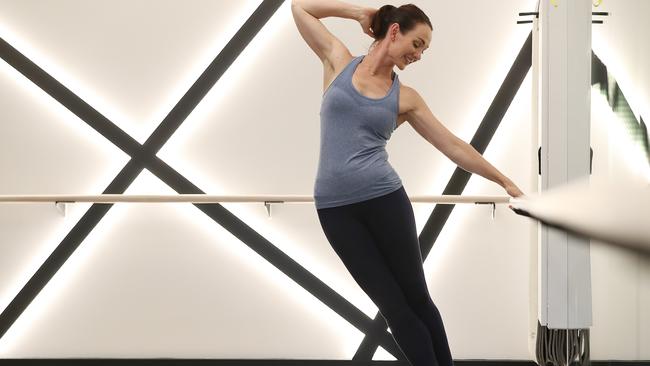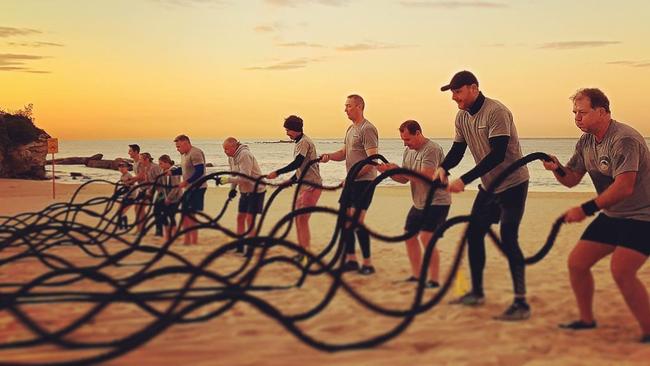Resolve to stick it out in 2020 to achieve your fitness goals
Start slowly. Establish the habit of regular exercise. Build it gradually and the results will surely follow.

By the morning of January 1, many New Year’s resolutions are already wilfully neglected — like the stale, flat half-glasses of bubbly scattered around the living room from the soiree the night before.
The easiest vows to ditch and delay are those designed to reduce the waistline. Anything to do with abstinence and exercise is pledged with one or two self-sabotage switches ready to flick.
We resolve to go dry with a glass already in hand — ready to be quaffed to celebrate the New Year. Resolution ruined within seconds of activation.
Booze bans and diets usually have to wait until after the festivities that run on until Australia Day. And February is such a handily short month for a stint of abstinence.
Bit sticky, though. Exercising in February’s humidity is a big ask. Can’t the fitness regimen wait until the autumn?
Time for The Australian to stage an intervention. We spoke to three of the nation’s fitness gurus about how to start — and stick with — that health kick in 2020, using minimal gear but fully equipped with the mental tools to resist self-sabotage.
Jim “Chief” Brabon is entering his 30th year as a pioneer of fitness training through Original Bootcamp, with franchises around the country. He and his wife, Emilie “Gunny” Brabon, are responsible for training most of those shirtless, newly muscled celebrities you see on the covers of the fitness magazines.
But the diet and exercise programs they use to achieve those celebrity transformations, and their new SKWOD Sweat and Social Club in The Rocks in Sydney, are based on less glamorous ideas. They often rely largely on body-weight exercises and simple — yet brutal — honesty with oneself.
Rohan Taylor is Swimming Australia’s technical director for Victoria and Tasmania. He sees swimming as the low-impact exercise for the whole body that also reshapes any negativity cluttering the mind.
And Shay Stafford is an author and former showgirl at the Lido and Moulin Rouge in Paris who brings those dance skills to her Xtend Barre exercise studio in Stones Corner, Brisbane.
Stafford combines dance moves, pilates and other stretching techniques to strengthen, tone and probably make you sick within a few sessions.
But don’t feel self-conscious, she says. The people beside you will be too exhausted to notice

Cardio and strength
Brabon: My main message is don’t go too hard too early. Aim for 20 to 30 minutes a day. Try to do that every work day at least. You want to create a habit that you can maintain until it becomes an automatic part of your day.
Each session should be a mix of cardio and strength. I wouldn’t recommend doing cardio one day and strength the next — it’s too easy to miss a day. Try to get it all into one session. Find a set of exercises that works different parts of the body. Do one or two sets on one exercise, then 20 seconds of an activity that really gets the heart rate up. Then return to another exercise and back to cardio.
Doing it all in one session is the most effective and efficient way to get the full benefit.
Start with exercises like squats or lunges that use a lot of the lower body. Push-ups are the best for the upper body. An abdominal crunch is very safe and effective for your trunk. Then you need something for the biceps. Pull-ups are the best but not everyone can do them. Some kind of rowing exercise will really help.
It’s much harder to reach your goals on your own. Try to find a group of friends or family to exercise with. Knowing that someone else is relying on you to turn up for training will help get you out of bed to create the new habits. Having people around you is good for morale and keeps you on track.
In the groups we run you see that people do a lot more than they would achieve on their own. You will feel self-conscious when you start. But in a group you can turn that into an advantage. In a group, you don’t want to be the one who quits. You worry about falling behind so you try a little harder and you realise that you can do a lot more than you thought you could.
Another of my key messages is to earn your treats. There’s no need to give up that beer or that dessert at the end of the week. But earn it.
A lot of people fall off the wagon — they miss a session, or overindulge with food and drink. Then they feel guilty and tell themselves they’ll make up for it at the next exercise session. But if they miss that session they feel even worse. The guilt builds, they hate themselves and give up the exercise. But they don’t give up the treats and bad habits.
Swimming
Taylor: It’s really important to find 30 minutes for exercise — whatever you’re doing (to keep fit) — five times a week. It’s hard to create that routine but any time you’re out of the comfort zone, it’s great. I see people who come in every day for their 30 minutes. Before long they just can’t do without it. Swimming sets them up for the day.
The main thing about swimming is that when you are in the water you are weightless and getting your main muscle groups working. It’s great exercise in itself but it also puts you into a more mindful state through controlled breathing.
Controlling your breathing — changing from four strokes to each breath to three strokes or two — is a great way to find a more mindful space if you’re an adult looking to escape or prepare for the pressures of life.
My mother has started swimming again at the age of 81. After years of me telling her to get in the pool, she loves it and is getting a lot out of it.
Start with one lap at a time. Rest until you can go again. Don’t get out of the pool until the 30 minutes is up. Mix it up with kickboards and different strokes. Fill that 30 minutes with anything you want to do.
Next time, try to maintain what you achieved in the last session and gradually build it up.
I would highly recommend doing the other strokes — not just freestyle. Backstroke and freestyle are crucial — they work different ranges of the shoulders. Breaststroke is also good, but butterfly requires more fitness and more technique.
If you have access to beginner lessons or stroke correction training for experienced swimmers, it’s a great idea. Some simple tips can really make a big difference.
Stretching
Stafford: People are generally very intimidated when they start and feel that if they’re not already flexible they can’t do Xtend Barre.
They forget that the only way to improve flexibility is to stretch. It’s the same in so many forms of exercise.
Starting a new exercise regimen is the hardest part because that’s when you have to overcome your self- consciousness. It doesn’t take long to realise everyone is struggling and sore. No one is looking at you — they’re working too hard to look around.
The other mistake people make is starting too hard. They make a New Year resolution with a vengeance and promise themselves that they will do a session every day. You can’t keep that up, and when they inevitably fail to exercise every day they feel terrible and quit.
I tell people to set a goal but to also remember the emotional reason they set that goal — to lose 5kg or run that half-marathon. I encourage people to consciously admit the emotional reason for setting their goals by telling someone or writing it down.
But from there it’s important to avoid going too hard early. Be realistic. Avoid injuries and gradually build endurance.
When people start barre they will feel sick occasionally. Their legs will tremble. But after a handful of sessions they will be able to track how they’re improving and they will know they are getting stronger. After six weeks other people will start to notice that they’re standing up straighter and looking better.
Start with a couple of sessions a week. Move your body every day if you can. Add in some cross- training or running when you can. But be kind to your body and to yourself at the same time.

To join the conversation, please log in. Don't have an account? Register
Join the conversation, you are commenting as Logout